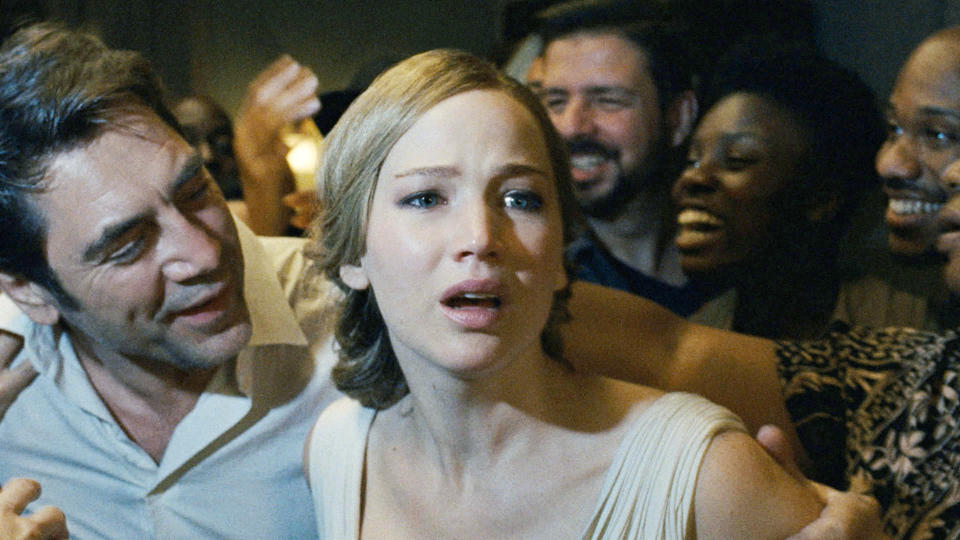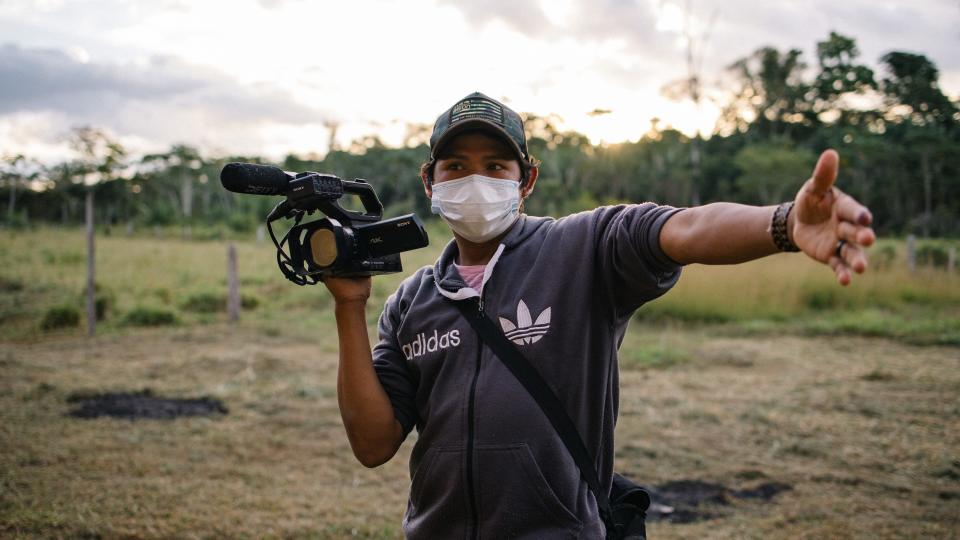Inside Darren Aronofsky’s Environmental Filmmaking Mission, from ‘Mother!’ to ‘The Territory’

- Oops!Something went wrong.Please try again later.
- Oops!Something went wrong.Please try again later.
Darren Aronofsky may be known for tense psychological dramas ranging from “Requiem for a Dream” to “The Wrestler,” and has another one in the pipeline this fall with “The Whale,” but the filmmaker has a side hustle with much loftier aims. As the producer of the National Geographic series “One Strange Rock” and “Welcome to Earth” through his company Protozoa Pictures, Aronofsky has been pushing for environmentally-conscious non-fiction projects in tandem with his own directorial undertakings, which he sees as a direct response to divisive Washington rhetoric.
“It’s a very sad state of affairs to call the environment political,” Aronofsky told IndieWire in a recent interview. “I don’t know how we lost control of that conversation.”
More from IndieWire
His latest effort on that front is “The Territory,” filmmaker Alex Pritz’s intense debut feature that follows the efforts of the Indigenous Amazon community called Uru-eu-wau-wau to protect their land from aggressive deforestation efforts. The Brazilian Indigenous community, which was uncontacted until the ‘80s, engages in fierce mobilization efforts as Pritz captures both sides of the battle; he also evades charges of Orientalism by ceding control to his subjects and allowing several of them, including ambitious 20-year-old Indigenous leader Bitaté, to take control of the footage.
The project started production in the aftermath of the election of the country’s president Jair Bolsonaro in 2018 and captures three years of internal conflicts as the Uru-eu-wau-wau struggle against the mounting existential threat around them, including the impact of the pandemic. After winning both the Audience Award and a Special Jury Award for Craft at Sundance, the movie was acquired by National Geographic, which releases it this week to kick off an awards season run. “It’s been a really great case study of what Protozoa likes to do,” Aronofsky said. “It’s the frontlines that will hopefully bring a lot of awareness to what’s happening there in a very real, human way.”
“The Territory” amounts to a harrowing and immersive look at the struggle to save the Amazon from the inside out: There are gripping moments in which activists confront workers destroying the forest, but Pritz also captures the perspectives of local farmers struggling to sort out their allegiances. Bitaté and fellow activist Neidinha Bandeira, a maternal figure for the younger man, engage in daring and often downright dangerous confrontations while contending with threats to their lives that inject the movie with the urgency of a real-life thriller.
Pritz was already deeply enmeshed in the project when Protozoa got involved, but the director said Aronofsky and his cohorts were critical to clarifying his vision and bringing it across the finish line. “We were a scrappy team,” Pritz said. “The Protozoa guys saw and respected that, which was cool. They were willing to roll up their sleeves and get dirty with figuring out out how to make this thing work.”
Protoza producers Dylan Golden and Brendan Naylor came across the project when Pritz was looking for support at the Gotham Film Week in 2019. Aronofsky’s own globe-trotting adventures made him both instantly engaged by the focus of the project and well-equipped to verify its potential. The director already knew one of the fixers that Pritz was using as a go-between in the Amazon and reached out to him to confirm the director’s legitimacy. “I was able to get an inside track on Alex,” Aronofsky said, “which was why we decided to step in and help guide the film. A big part of our mission at Protozoa is to make films that talk about the environment and science while helping new filmmakers.”

Paramount/Courtesy Everett Collection / Everett Collection
Initially, Aronofsky said, he aimed to inject that impulse into his own filmmaking efforts, beginning with his 2014 Biblical epic “Noah,” an ambitious studio epic that received a mixed response. “I was trying to point out that there’s a story about environmentalism that’s the fourth one in the Bible, something that’s been a part of our literature and history for a long time,” he said. “I was trying to depoliticize it in whatever way I could. The goal here is to be real honest and clear.”
A few years later, he switched modes with the allegorical “mother!,” a creation story about the fragility of the Earth under the guise of a dark relationship drama. “‘mother!’ was very much an outgrowth of what I was reading, thinking, and seeing happen to the environment,” he said. “I just wanted to create a howl as loud as I possibly could.”
“The Territory” aims for a similar effect in more direct terms: Set for a release in Brazil three weeks before its latest presidential election, where Bolsonaro is struggling in the polls, it has the potential to have a direct impact on the malicious force at its center. In the 2018 election, 78 percent of voters in the region where the movie takes place voted for Bolsonaro. “I hope the film can be part of the political conversation by reframing parts of Bolsonaro’s legacy,” Pritz said. “The hope is that different groups of people can look at the film and see the devastation and violence that’s been wrought — the effects of political discourse on real human lives.”
Protozoa has big plans for expanding its environmental projects. Aronofsky declined to comment on the state of “Pole to Pole,” another National Geographic series Aronofsky had been developing with a pre-Slap Will Smith as host, but said he was excited about “Sentient,” another upcoming NatGeo series he was producing focused on animal intelligence. “These big natural history shows take two or three years to actually get done,” he said, “but soon you’ll see that we’re fully leaning into environmental stories.”
With “The Territory,” Aronofsky said he was impressed by the level of risk on display, as the movie takes place in a region where a British journalist was murdered by pro-Bolsonaro forces in June. “It’s really the Wild West out there,” he said. “I think this was just a really bold move that will bring a lot of awareness to what’s happening in a real human way.”
The Protozoa team encouraged Pritz to embrace the genres at the center of the story that contributed to its thrilling momentum. “They pushed us to go in a more cinematic direction,” Pritz said. “I started to think of it as a Western more than a documentary.” That also allowed him to capture wartime suspense without taking an obvious side in the battle. “It was an extremely hostile environment where people are working to protect the environment, but we had to work both sides of the conflict, which was a fine line to straddle.”

Courtesy of filmmaker
Whatever happens with Brazil’s election, “The Territory” has already changed the lives of its subjects, some of whom became filmmakers as a result of it. Pritz initially gave cameras to the Uru-eu-wau-wau participants to develop his relationship with his subjects, but that led to bigger plans. “Originally, it was all about building up trust in the community,” he said. “Most of the people in the community had never seen a film before. The best way we found to initiate that conversation was to bring cameras to see how it feels to be on both sides of them.”
Now, Bitaté is on the verge of beginning the journalism program at the University of Rondônia, and Pritz is helping create more long-term opportunities for the community that contributed to the production. Working with a consortium of Indigenous media collectives as well as Midia India, Pritz has been shepherding along plans to create the Jupaú Media Hub and Cultural Center, a brick-and-mortar space where members of the Uru-eu-wau-wau can continue to develop their work as filmmakers and photographers.
The funding goes to the creation of a production center that will include an open-air screening space with a facility at the center for equipment and a podcasting studio. There are plans for filmmaking workshops and efforts to translate the film into the indigenous language, since most elders in the region don’t speak Portuguese. Site surveys were completed with local architects earlier this summer. “It’s much bigger than it was originally envisioned,” Pritz said. “It’s a whole other chapter in this impact campaign.”
Pritz, who was promoting “The Territory” in tandem with his work on a new project focused on the Ethiopian Space Science Institute, said he hoped the movie would resonate in the U.S. as much as it has in Brazil. “I hope people can watch it and not see it and not see it as some Brazilian film, but that it can connect the dots between the colonial project in America and the colonial project in Brazil,” he said. “A lot of the same things that happened in the United States 150 years ago are now playing out in Brazil — the genocide against indigenous people in the U.S. — and that should not be foreign to American audiences.”
Aronofsky, meanwhile, might just make Oscar history this season. If “The Whale” winds up with nominations for Best Director or Best Picture and “The Territory” gets a Best Documentary nomination, he would be the first person in history to score nominations for narrative and documentary features in the same year. Asked about this possibility, Aronofsky focused on the advocacy at hand. “The importance of the awards are just to help small films,” he said. “That’s the way I feel. The big films have all the support they generally need. The more laurels we can put on the poster the better for this movie.”
National Geographic Documentary Films releases “The Territory” in theaters on Friday, August 19.
Best of IndieWire
All the Details on 'Hunger Games' Prequel 'The Ballad of Songbirds and Snakes'
New Movies: Release Calendar for August 19, Plus Where to Watch the Latest Films
Sign up for Indiewire's Newsletter. For the latest news, follow us on Facebook, Twitter, and Instagram.

